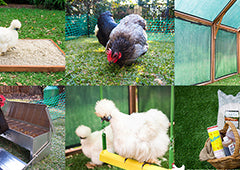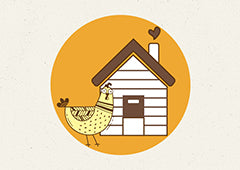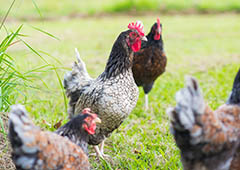Many of us have experienced that awkward moment of accidentally calling a friend’s dog a “she”, when they are quite clearly a “he”. In the same way as we might pet a neighbour’s cat and coo, “aren’t you a handsome boy” only to be told in deft terms, “it’s a girl”. Sometimes this is the product of a mere accident or oversight, but on some occasions, especially in terms of Guinea fowl, it is quite difficult to tell whether or not it’s a boy or a girl. Though there may not be a huge amount of visible differences that make male and female Guinea fowl distinct from one another, it is important that you are aware of the sexes in your flock, otherwise you might find yourself with an overwhelming amount of keets very quickly.
Male Guinea fowl
Male Guinea fowl look very similar to females however if you have a keen eye and a sharp ear, you may be able to tell the difference. Firstly, male Guinea fowl are distinguishable by the larger size of their wattles and helmet. In case you are unaware, the helmet is the protrusion that sticks out from the tops of their heads, and the wattles are the giggly jowls that hang around their cheeks. Also, the male Guinea fowls tend to make a sharper one syllable cry that sounds slightly like “CHI-CHI-CHI”, which you can listen to below. Finally, this is more difficult, but you can feel the rear bone structure of the bird, by gently holding the bird under one arm and feeling around the pelvis of the Guinea fowl; a male Guinea fowl should have about one finger width of space between their pelvic bones.
[embed]https://www.youtube.com/watch?v=_L9Sj1RCVYQ[/embed]Female Guinea fowl
Female Guinea fowl are quite different from male Guinea fowl in terms of their call. Female Guinea fowl tend to make a two syllable cry that sounds slightly like “buck-wheat”, which you can listen to below. The tricky thing about female Guinea fowl is that they can also imitate the “CHI-CHI-CHI” sound of the males quite easily. Additionally, female Guinea fowl tend to have about three fingers width of space between the bones in the pelvis. Also, female Guinea fowl tend to have smaller wattles and helmets than their male counterparts.
[embed]https://www.youtube.com/watch?v=z5GnmSg0ct4[/embed]Sexing Guinea fowl keets
Unfortunately, sexing Guinea fowl keets is incredibly difficult- almost impossible. Consult with the breeder that you are purchasing them from, as they may have a slightly better idea. However, Guinea fowl don’t really come into their gender before they are eight weeks old.
Guinea fowl are monogamous
An important side note to sexing Guinea fowl is the fact that they are monogamous creatures that prefer to breed for life. For this reason, if you intend to breed Guinea fowl, it’s important that you buy some while they’re young and they will naturally start to partner off. If something terrible were to happen to either the male or the female in the partnership, it is unlikely that the remaining Guinea fowl will take another partner, instead, preferring to spend their remaining days alone. Unlike chickens, like ISA Browns and Plymouth Rocks, that have no qualms about getting friendly with any old rooster. This being said, some Guinea fowl do find the strength to overcome their loss and breed with another male or female, however this is not often the case.
Guinea fowl are incredibly unique birds even when it comes to determining the boys from the girls. Nevertheless, the easiest way to tell them apart is to listen to the sound of their calls- and if that fails, take a closer look at their wattles, jowls, as well has having a feel of their pelvic bones.
If you’re thinking about getting some Guinea fowl, make sure you have a nice, safe and strong coop for them to sleep in at night, like the Taj Mahal, Penthouse or Mansion coop. As they prefer to breed for life, it’s important for Guinea fowl couples to have a nice house to go home to at the end of the night.
If you’d like to know more about Guinea fowl, including a great article about how to keep them with chickens, simply click here.

















